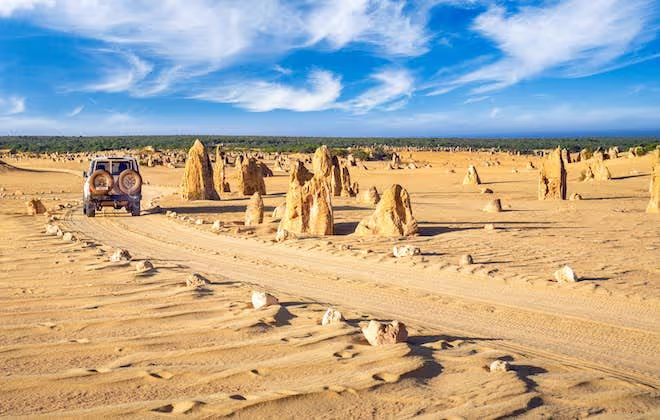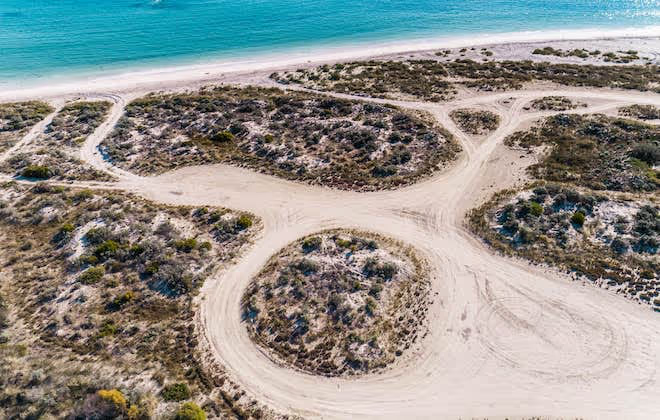Tour destinations
Responsible tourism


Nambung National Park is 200 kilometres northwest of Perth in the Wheatbelt region of Western Australia. The park is most famous for the Pinnacles Desert, with its thousands of limestone spires rising eerily out of the yellow sandy earth. Lake Thetis is another dramatic place with its fascinating Thrombolites, living fossils that are over 3,000 years old.
There’s much to explore in WA’s beautiful Nambung National Park. Just 17 kilometres south of the coastal town of Cervantes, the park features secluded sandy beaches with clear waters ideal for swimming, snorkelling or just relaxing on the beach and spotting the bottlenose dolphins or sea lions close to shore or humpback whales during migration season.

Take the first step toward your next adventure—explore our tours or get a free brochure sent to your inbox.
Pinnacles Desert is by far the highlight of Nambung National Park and has become one of the most visited natural tourist attractions in WA. Walking or driving through this sandy desert surrounded by thousands of ancient, weathered, limestone rock spires is a memorable experience.
The spires date back between 25,000 and 30,000 years. Some of the pillar-like formations are tall, narrow, and jagged reaching up to 3.5 metres while others are small, smooth, and curved and only stand about a metre high. Spread out across the yellow desert, they take on an ‘other-worldly’ feel making them seem surreal.
For thousands of years the spires, and surrounding area have been a sacred place for Indigenous Nyoongar women. They met here to do women’s business, hold ceremonies, collect food, and give birth. In 1967, the Pinnacles area was gazetted as a reserve and later became part of Nambung National Park.


The tiny fishing town of Cervantes marks the start of WA’s Coral Coast region and boasts stunning beaches and abundant marine life. It’s a popular spot for those who love boating, fishing, or diving and its most popular catch is delicious, fresh lobster!
As well as visiting the Pinnacles Desert, tourists flock to Lake Thetis, one of only five sites in the state that features Thrombolites believed to be over 3,000 years old. These ancient living fossils are closely related to Stromatolites that are around 3.5 billion years old.
One of the interesting things about Cervantes is how it earned its name. Cervantes was an American Whaling ship that was extensively damaged during a storm while anchored at Jurien Bay in 1844. The ship was named after Miguel de Cervantes, the renowned Spanish author of Don Quixote. Today, most of the streets in Cervantes are named after cities, rivers, and regions of Spain.
Nambung National Park covers an area of just over 190 square kilometres.
Nambung National Park gets its name from the traditional owners of Nambung National Park, the Yuat people. The word means ‘winding’ or ‘crooked’ referring to the Nambung River which flows into the park, then disappears underground into a limestone cave.
Emus frequent the Pinnacles Desert along with Western grey kangaroos who graze on the vegetation. There are also dingoes, possums and red foxes, sand goannas, carpet pythons and bobtails. Baudin’s black cockatoo with its distinctive white ear patch and white tail panel may also be seen there.
It doesn’t matter what time of year, or what time of day or night you visit The Pinnacles Desert, you’ll always be greeted with a fascinating sight. For photography, sunrise or sunset gives the pillars a warm golden glow, casting eerie shadows on the sand. After dark with a torch in hand and a star-filled sky, the Pinnacles are a wondrous place to explore.
Native wattle and banksia can be seen in the park, along with quandong, cockies tongue, parrot bush, yellow tailflower, thick-leaved fan flower and banjine.
Between August and October, Nambung National Park puts on a colourful display of stunning Spring wildflowers.
Our team is always happy to help if you have any questions about us or our tours. Fill out our form and we will get back to you soon.